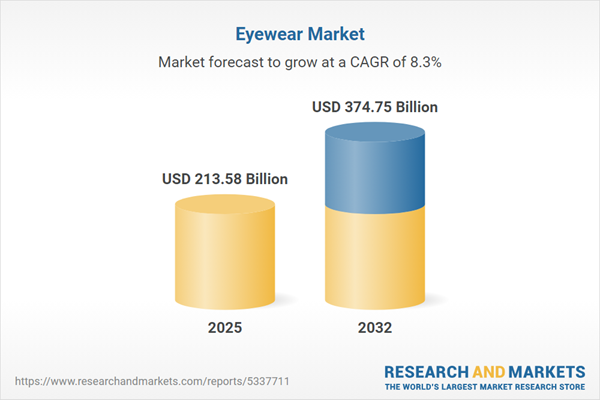Speak directly to the analyst to clarify any post sales queries you may have.
The eyewear market is evolving rapidly as technology innovation, consumer preferences, and regulatory expectations reshape industry priorities. Senior leadership teams need actionable market intelligence to anticipate challenges, uncover growth potential, and maintain strategic clarity in a complex, global landscape.
Market Snapshot: Eyewear Market Size and Momentum
In 2024, the global eyewear market reached USD 197.85 billion and is expected to rise to USD 213.58 billion by 2025, progressing to USD 374.75 billion by 2032. This market growth, anticipated at a compound annual growth rate (CAGR) of 8.31%, is underpinned by ongoing advances in visual correction technologies, heightened awareness of eye health, and a steady flow of innovative product designs. Leading industry players are leveraging these drivers to secure stronger market positioning and identify new avenues for business expansion.
Scope & Segmentation of the Eyewear Market
This market research report provides senior decision-makers with a structured analytical framework to navigate industry complexity, foster opportunity assessment, and strengthen strategic planning across the global eyewear value chain. Deep segmentation helps executive teams manage portfolios, operational planning, and competitive differentiation:
- Product Types: Covers spectacles, contact lenses, protective eyewear, and sunglasses—addressing design choices such as full rim, rimless, and semi rimless, alongside functional distinctions like polarized and non-polarized lenses.
- Lens Types: Segments the market into bifocal, progressive, and single vision lenses, supporting personalization and advancing solutions for varied vision correction needs.
- Materials: Differentiates eyewear frames based on metal or plastic materials, evaluating these by durability, flexibility, and influence on product lifecycle and brand identity.
- Distribution Channels: Outlines both offline and online sales routes, spanning pharmacies, department stores, and the rise of e-commerce, reinforcing evolving omnichannel strategies and expanded customer outreach.
- End Users: Analyzes demand across adults, seniors, and children, providing executive insights into consumption dynamics and comfort, wellness, and user engagement trends.
- Gender: Illustrates men’s, women’s, and unisex product segments, reflecting how identity and lifestyle considerations shape purchasing decisions.
- Geographies: Examines market activity across the Americas, Europe, Middle East and Africa, and Asia-Pacific, offering country-specific analysis for China, India, Japan, Australia, South Korea, Indonesia, Thailand, Malaysia, Singapore, and Taiwan.
- Companies: Benchmarks leading players such as Carl Zeiss AG, EssilorLuxottica SA, Alcon Vision LLC, Bausch + Lomb Corporation, Hoya Corporation, Johnson & Johnson Vision Care, Kering SA, and LVMH Group, with profiles supporting peer comparison and best practice identification.
Key Takeaways for Senior Decision-Makers
- Innovative eyewear features like smart lenses and advanced coatings are transforming product differentiation, providing new pathways for competitive advantage and consumer engagement.
- Digital integration with physical retail channels is reshaping sales approaches, intensifying customer interaction, and supporting brands in establishing loyalty within an evolving omnichannel retail environment.
- Commitments to responsible sourcing and sustainable manufacturing are now central to regulatory compliance and appeal to a global buyer base prioritizing environmental considerations.
- Diversification, driven by innovation in frames and high-performance contact lenses, aligns product lines with individual consumer requirements, including health, comfort, and personal style.
- Regional market strategies must address the contrasts between mature markets—where technology adoption leads—and fast-growing economies, where accessible multi-use products respond to broadening demand.
Tariff Impact: U.S. Supply Chain Realignment
Anticipated U.S. tariffs on component imports from 2025 are prompting organizations to reevaluate supply chain structures. There is a renewed focus on localized sourcing, contract renegotiation, and transparency in pricing to ensure regulatory adherence and operational resilience. Enhanced procurement flexibility and compliance programs are now a strategic priority for maintaining business continuity amid evolving regulatory environments.
Methodology & Data Sources
The research applies a triangulated methodology, combining interviews with industry manufacturers, distributors, and sector experts, together with secondary source reviews. This approach delivers reliable, actionable insights that support stakeholders throughout every phase of the global eyewear market.
Why This Eyewear Market Report Matters
- Empowers executive teams to make informed, evidence-based decisions with clear analysis of market drivers and challenges in a continuously changing business environment.
- Enables targeted market analysis and efficient resource allocation by providing comprehensive segmentation and benchmarking across regions and leading companies.
- Strengthens the ability to manage regulatory and industry shifts proactively, supporting sustained competitiveness and preparedness for change.
Conclusion
Adapting to the dynamic eyewear industry requires data-led strategy and continuous alignment with evolving trends. This report equips senior leadership with insights for agile planning and ongoing organizational performance.
Additional Product Information:
- Purchase of this report includes 1 year online access with quarterly updates.
- This report can be updated on request. Please contact our Customer Experience team using the Ask a Question widget on our website.
Table of Contents
3. Executive Summary
4. Market Overview
7. Cumulative Impact of Artificial Intelligence 2025
Companies Mentioned
The companies profiled in this Eyewear market report include:- Carl Zeiss AG
- EssilorLuxottica SA
- Alcon Vision LLC
- Bausch + Lomb Corporation
- Blanchard Laboratories, LLC
- Contamac Ltd.
- CooperVision, Inc.
- De Rigo Vision S.p.A.
- Fielmann Group AG
- Hoya Corporation
- Johnson & Johnson Vision Care, Inc.
- Kering SA
- LVMH Group
- Marchon Eyewear, Inc. by VSP Vision Care Company
- Marcolin S.p.A.
- Menicon Co., Ltd.
- MOSCOT
- Prada S.p.A.
- Precilens SAS
- Precision Technology Services, LLC
- Safilo Group S.p.A.
- SEED Co., Ltd.
- Silhouette Group
- UltraVision CLPL Ltd.
- X-Cel Specialty Contacts, Inc.
Table Information
| Report Attribute | Details |
|---|---|
| No. of Pages | 184 |
| Published | November 2025 |
| Forecast Period | 2025 - 2032 |
| Estimated Market Value ( USD | $ 213.58 Billion |
| Forecasted Market Value ( USD | $ 374.75 Billion |
| Compound Annual Growth Rate | 8.3% |
| Regions Covered | Global |
| No. of Companies Mentioned | 26 |









